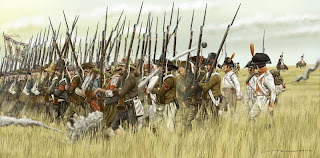 |
| Royal Standard of Texas (my own design anyway) |
The big push for Spanish settlement in Texas came as a result of another claim on Texas by the Kingdom of France and it was one made by accident. The intrepid explorer Rene Robert Cavalier de La Salle missed Louisiana and crashed onto the Texas coast in 1685 on the shores of Lavaca Bay. He claimed the land for His Most Christian Majesty King Louis XIV and established Fort St Louis. Eventually, a party determined to set out on foot for New France (which means they intended to walk to Canada) but there was a mutiny and La Salle was killed. Eventually, most of the remainder were killed by the Karankawas (the first to eat French cuisine in Texas) and this French incursion prompted Spain to take action. A Spanish expedition was dispatched to expel the invaders though when they arrived they found only the ruins of the old fort. The largely nominal reign of the King of France over Texas ended in 1690 but it was still very important in lighting a fire under the Spanish. Just the French being in Louisiana, between Spanish Texas and Florida, was considered a threat to Spanish trade and interests in the region. So, the Council of War of King Carlos II (the last Hapsburg to reign over Texas) recommended that action be taken to fortify the frontier.
1690, under King Carlos II, was when things really got moving in Texas. A string of stone forts and missions (which often doubled as forts) were established across the eastern half of Texas in a line running down from the border with Louisiana (which was disputed), near the coast down to south Texas. Famous examples of these beautiful structures can be seen in the missions of San Antonio or the presidio La Bahia in Goliad, Texas and mass is still said in all of them. The most famous mission, of course, is the Mission San Antonio de Valero, even though it was never finished, named after St Anthony of Padua and the Viceroy of New Spain but better known as the Alamo. The idea was to establish a network of fortified bases to discourage any French attacks coming out of Louisiana as well as to convert the natives to Christianity, protect those engaged in farming from those engaged in pillaging and to settle and civilize the area. However, the inhabitants of what is today Mexico proved very reluctant to move to Texas so settlers were often brought in from great distances. Most of the original settlers of San Antonio, for example, were from the Canary Islands. It was not until 1715, for example, that the first Spanish women arrived in Texas as part of colonization efforts undertaken by King Felipe V, the Bourbon prince who had come to the Spanish throne after the death of the unfortunate Carlos II.
 |
| courtyard of the Spanish Royal Governor's Palace |
The Spanish colonies refused to recognize the legitimacy of King Jose I whose nominal reign lasted from 1808 to 1813. However, the lack of a strong government in Spain that everyone was loyal to caused rebellion to break out in many parts of the Spanish empire. Foreign filibusters also took advantage of the chaos to try to to grab Texas away from Spain. It was the rough start to what would later be known as the first Mexican Revolution. One of the biggest threats to royal authority in Texas was the Magee-Gutierrez Expedition, made up of a combination of American filibusters and Mexican revolutionaries. They invaded and took control of much of Texas in 1812-13. However, a Spanish royalist army under General Joaquin de Arredondo marched up from the south and defeated the republican army at the battle of Medina, the largest battle ever fought on Texas soil. The reign of King Fernando VII over Texas had been saved but only for the time being.
Eventually, the policies coming out of Madrid alienated the conservatives in New Spain and they began to join the independence movement. The leader of the new coalition was Don Agustin de Iturbide. He wanted New Spain, which is to say Mexico and Central America, to be independent but still under the Spanish Crown. However, King Fernando VII refused and forbid any of his family to accept the crown of Mexico. Nonetheless, independence could not be stopped and in 1821, by popular acclaim, General Iturbide became Emperor Agustin I of Mexico, which of course included Texas at that time. In fact, it was under the reign of Emperor Agustin I that the first steps were taken toward the Anglo colonization of Texas by the "Father of Texas" Stephen F. Austin. His father had received a land grant from the Spanish in 1820 but it was Stephen F. Austin who led the first official Anglo colonization of Texas, giving birth to Texas as we know it today in late 1821. The change in government threw things into confusion and Austin had to go to Mexico City to sort it all out but his plan was ultimately approved by the Emperor. Unfortunately, things had hardly had time to settle when Emperor Agustin was overthrown in 1823 by liberal republicans led by a man who would later become infamous in Texas history, one Antonio Lopez de Santa Anna. Mexico became a republic and Texas became an independent Republic in 1836 making Emperor Agustin the last man to reign over Texas as monarch.



.svg.png)



No comments:
Post a Comment